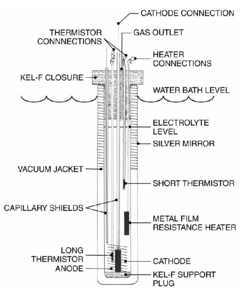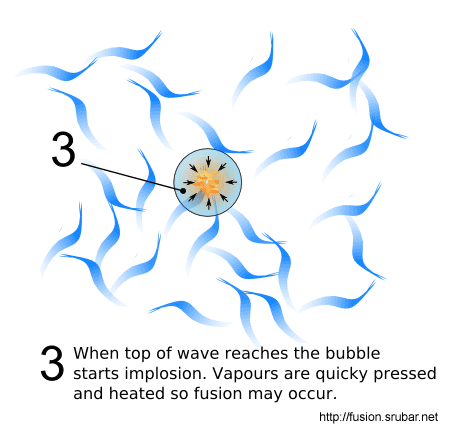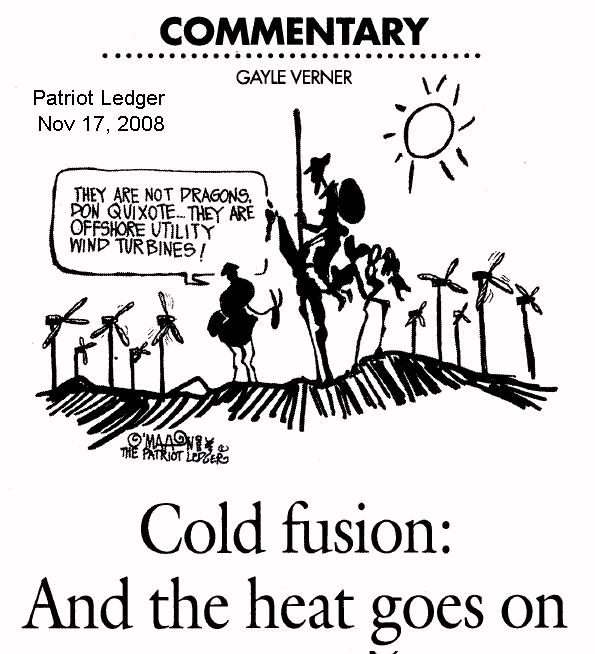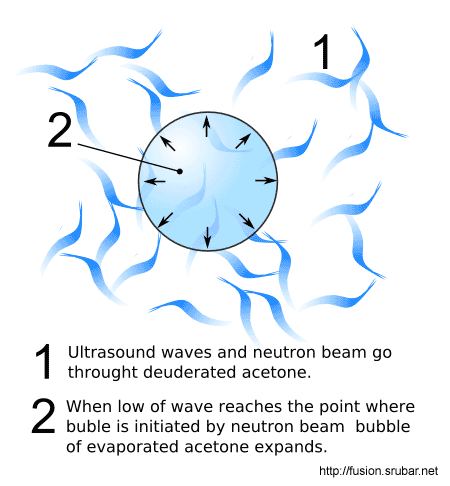Cold fusion gained attention after reports in 1989 by Stanley Pons and Martin Fleischmann, then one of the world's leading electrochemists, that their apparatus had produced anomalous heat ("excess heat"), of a magnitude they asserted would defy explanation except in terms of nuclear processes. They further reported measuring small amounts of nuclear reaction byproducts, including neutrons and tritiumas well as an excess of heat. The small tabletop experiment involved electrolysis of heavy water on the surface of a palladium (Pd) electrode.
 The results were never duplicated and most scientists and the media and highly skeptical of cold fusion claims.
The results were never duplicated and most scientists and the media and highly skeptical of cold fusion claims.The reported results received wide media attention, and raised hopes of a cheap and abundant source of energy. Many scientists tried to replicate the experiment with the few details available. The major problems with Pons and Fleischmann's "cold fusion" is that there was no verified measurement of neutron radiation, an impossibility if fusion had indeed occurred. Cold fusion continues to be promoted and studied but it is considered a "fringe" or pseudoscience by most. Cold fusion experiments include using a metal like nickel or palladium, deuterium and hydrogen, and a method to energize or excite the atoms. Methods that have been attempted include electrolysis, lasers, magnets and the traditional pressure and heat.
Hopes fell with the large number of negative replications, the withdrawal of many positive replications, the discovery of flaws and sources of experimental error in the original experiment, and finally the discovery that Fleischmann and Pons had not actually detected nuclear reaction byproducts. In 1989, a review panel organized by the US Department of Energy (DOE) found that the evidence for the discovery of a new nuclear process was not persuasive enough to start a special program, but was "sympathetic toward modest support" for experiments "within the present funding system." A second DOE review, convened in 2004 to look at new research, reached conclusions similar to the first. Some researchers continue to investigate cold fusion, now often preferring the designation low-energy nuclear reactions (LENR). Some have reported that, "under certain extreme conditions", they observe excess heat effects by interaction of hydrogen or deuterium with palladium, nickel or platinum. Since cold fusion articles are rarely published in refereed scientific journals, the results do not receive as much scrutiny as more mainstream topics.
Some other confinement principles have been investigated, some of them were confirmed to run nuclear fusion but without any possibility to produce net power, the others were not even proven to produce fusion. Sonofusion or bubble fusion, a controversial variation on the sonoluminescence theme, suggests that acoustic shock waves, passing through bubbles (cavitation) that expand and collapse shortly after creation, can produce temperatures and pressures sufficient for nuclear fusion. In the Oak Ridge experiments, the hydrogen in acetone (C-3 H-6 O), the principal ingredient in nail polish remover, is replaced by the heavier deuterium isotope. Sound waves are passed through the liquid at the same time as a pulse of high energy neutrons.

It is hypothesized that the acoustic bubbles which form, then collapse so fast that not only is light produced, but the deuterium is somehow caused to undergo nuclear fusion. The evidence for this is in the excess of neutrons and tritium, a heavier isotope of hydrogen, detected in the solution. The amounts are very small, however, and the existence of the effect is being challenged. The absence of neutrons in sononfusion debunked the theory of cold fusion for this method. The simple fact that there was background neutrons present via pulse neutron generator which created the bubble in the first place, ruled out any concrete evidence.
Now, from Italy, comes the stunning news that Low Energy Nuclear Reactors (LENR) are, suddenly, a practical reality consistently generating significant power.
Focardi and Rossi recently had a public demonstration of a desktop-sized reactor that produces 11 kW of net power for extended periods of time. Both the fuel and residues are clean and free of radioactivity. The fuel is nickel powder and a tiny amount of hydrogen. A gram of nickel generates 2000 kilowatt-hours in this prototype. On January 14, 2011 a public demonstration was held at the University of Bologna with about 50 attendees. The U.S. press totally ignored this momentous event. It had been burned before by the “cold fusion” announcement in Utah an 1998. What most people don’t know is that the declaration that cold fusion was “junk science” was really “junk criticism,” encouraged by powerful interests. Much like the “climate skepticism” of today. In 2009, DARPA issued an analysis report reversing their previous negative position on cold fusion. Engineering has trumped science. We now know how to make low energy reactions generate power, but there are still many mysteries in the explanation.
 Dr. Focardi has been publishing strong results with nickel-hydrogen fusion since 1994. A 1996 paper reported two cells that ran 300 days producing 250 and 167 kilowatt-hours of excess heat.
Dr. Focardi has been publishing strong results with nickel-hydrogen fusion since 1994. A 1996 paper reported two cells that ran 300 days producing 250 and 167 kilowatt-hours of excess heat.
Andrea Rossi is an inventor and businessman who hired Dr. Focardi in 2007 as a consultant. He has been financing the entire development with his own money. Rossi's design uses a nickel powder with catalysts instead of nickel sheets. It is therefore capable of producing much more power. In 2010 they jointly published a paper that reported six different experiments with durations of up to 52 days. The longest experiment used 19 kWh of energy input to produce 3768 kWh of output energy. Output/input power ratios as high as 415 were obtained but, in the interest of safety and stability, the device demonstrated on January 14th runs at a power gain ratio of only 15.
 The theory of using electrolysis of heavy water and lithium salts with platinum as a anode and palladium as the cathode is basically no different to the early experiments of Stanley Pons and Martin Fleischmann. The basic circuit of the hydrogen ions are attracted to the palladium while oxygen hydrogen ions are form back to oxygen and hydrogen molecules. Given enough current the cycle of heavy water turning to oxygen molecule in the positive electrode. While the two hydrogen ions neutralizes its charge on the surface of the palladium negative electrode. The Super-wave function is to vary the voltage intensity for the electrolysis cell to force the hydrogen within the subatomic lattice of the palladium, and not just on the the surface. Once the Palladium lattice is saturated with ions, the theory is the structure forces the ions to fuse together. In essence nuclear fusion is achieved within a subatomic lattice. The disadvantaged is the regularity of fusion depends on the palladium as a uniform lattice. Despite these problems of regular heat being achieved people are now beginning to turn around to the possibility. This new experiment has yet to mention neutron detection or any other radiation. Instead only temperature is measured for the experiment, given that excessive amount of heat is released compared to the amount of energy in the form of electricity is fed into the cell. In my own conclusion I think its a sound theory which explains how the hydrogen ions are fused. I only think its too early to say that cold fusion works. The nature of experiment would suggest that nanotechnology might play a major part in the construction of the electrodes, as the key to fusion of this type requires a uniform lattice. Experiments in the 80's by Stanley Pons and Martin Fleischmann might have failed due to the lack of theory on the atomic level...
The theory of using electrolysis of heavy water and lithium salts with platinum as a anode and palladium as the cathode is basically no different to the early experiments of Stanley Pons and Martin Fleischmann. The basic circuit of the hydrogen ions are attracted to the palladium while oxygen hydrogen ions are form back to oxygen and hydrogen molecules. Given enough current the cycle of heavy water turning to oxygen molecule in the positive electrode. While the two hydrogen ions neutralizes its charge on the surface of the palladium negative electrode. The Super-wave function is to vary the voltage intensity for the electrolysis cell to force the hydrogen within the subatomic lattice of the palladium, and not just on the the surface. Once the Palladium lattice is saturated with ions, the theory is the structure forces the ions to fuse together. In essence nuclear fusion is achieved within a subatomic lattice. The disadvantaged is the regularity of fusion depends on the palladium as a uniform lattice. Despite these problems of regular heat being achieved people are now beginning to turn around to the possibility. This new experiment has yet to mention neutron detection or any other radiation. Instead only temperature is measured for the experiment, given that excessive amount of heat is released compared to the amount of energy in the form of electricity is fed into the cell. In my own conclusion I think its a sound theory which explains how the hydrogen ions are fused. I only think its too early to say that cold fusion works. The nature of experiment would suggest that nanotechnology might play a major part in the construction of the electrodes, as the key to fusion of this type requires a uniform lattice. Experiments in the 80's by Stanley Pons and Martin Fleischmann might have failed due to the lack of theory on the atomic level...


No comments:
Post a Comment